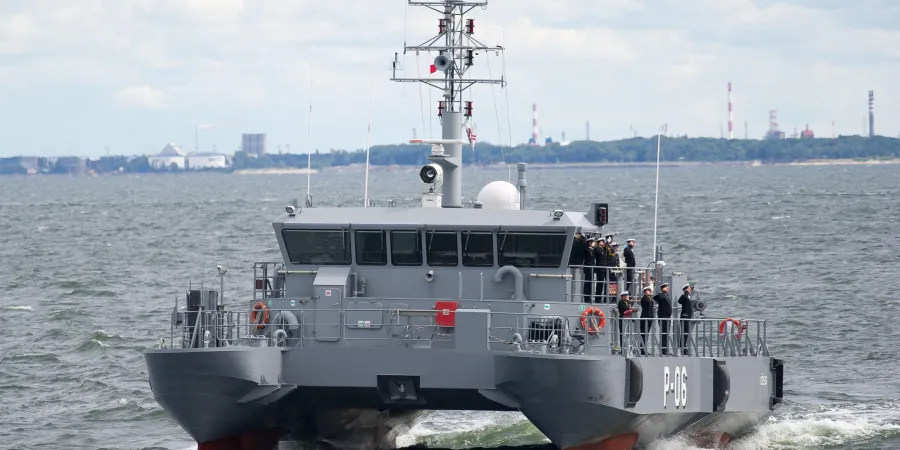Controp Delivers Naval Surveillance System to Latvian Navy
The iSea-30HD system was designed for various maritime vessels and is already operational with the Latvian Navy as well as other navies worldwide
IsraelDefense
| 25/10/2018
Controp Precision Technologies announced it is providing the Latvian Navy with the iSea-30HD system to enhance the Navy's maritime surveillance capabilities. The system was designed for various maritime vessels and is already in operational use by the Latvian Navy as well as other navies worldwide.
As part of the contract, the company provided the Latvian Navy with a complete ILS package, including training, operator and technical manuals and spare parts.
The iSea-30HD’s stabilization system enables a stable, continuous, and uninterrupted line-of-sight (LOS) – ensuring clear picture even in rough seas, the company says. The robust system withstands harsh environmental conditions including fog, salinity, and moisture. The iSea-30HD interfaces with other onboard systems, including the vessel's radar system providing slew-to-cue functionality. The system comprises the payload electronics box, a Control Unit (CU), a display, DVR and UPS.
“With the iSea-30HD naval surveillance system, Controp provides navies facing the challenges of current marine requirements with the full situational awareness capabilities crucially needed for their Search & Rescue missions and for their ongoing security and safety patrol operations,” says Controp’s VP Marketing Ra'anan Shelach. “To mention but one of the iSea-30HD’s benefits, is its real-time live images that can be transmitted from the scene to the operational center which enables quick and effective decision making even during limited visibility conditions,” he adds. “Another example is the system’s ability to detect small floating objects previously undetectable by the vessel’s radar, hence facilitating safe and easy entrance and exit of ports.”
Elaborating on the iSea-30HD’s features, Shelach says that the low-weight, gyro-stabilized system provides maximum-range surveillance. The system’s highly sensitive sensors include a high performance 3-5µ IR detector based Thermal Imaging (TI) camera, with a continuous zoom lens, a high definition color day camera, and an Eye-safe Laser Range Finder (LRF). The system also features advanced image processing and video enhancement algorithms, Automatic Video Tracker (AVT) and an Automatic Gain Control (AGC).
The iSea-30HD system was designed for various maritime vessels and is already operational with the Latvian Navy as well as other navies worldwide
Controp Precision Technologies announced it is providing the Latvian Navy with the iSea-30HD system to enhance the Navy's maritime surveillance capabilities. The system was designed for various maritime vessels and is already in operational use by the Latvian Navy as well as other navies worldwide.
As part of the contract, the company provided the Latvian Navy with a complete ILS package, including training, operator and technical manuals and spare parts.
The iSea-30HD’s stabilization system enables a stable, continuous, and uninterrupted line-of-sight (LOS) – ensuring clear picture even in rough seas, the company says. The robust system withstands harsh environmental conditions including fog, salinity, and moisture. The iSea-30HD interfaces with other onboard systems, including the vessel's radar system providing slew-to-cue functionality. The system comprises the payload electronics box, a Control Unit (CU), a display, DVR and UPS.
“With the iSea-30HD naval surveillance system, Controp provides navies facing the challenges of current marine requirements with the full situational awareness capabilities crucially needed for their Search & Rescue missions and for their ongoing security and safety patrol operations,” says Controp’s VP Marketing Ra'anan Shelach. “To mention but one of the iSea-30HD’s benefits, is its real-time live images that can be transmitted from the scene to the operational center which enables quick and effective decision making even during limited visibility conditions,” he adds. “Another example is the system’s ability to detect small floating objects previously undetectable by the vessel’s radar, hence facilitating safe and easy entrance and exit of ports.”
Elaborating on the iSea-30HD’s features, Shelach says that the low-weight, gyro-stabilized system provides maximum-range surveillance. The system’s highly sensitive sensors include a high performance 3-5µ IR detector based Thermal Imaging (TI) camera, with a continuous zoom lens, a high definition color day camera, and an Eye-safe Laser Range Finder (LRF). The system also features advanced image processing and video enhancement algorithms, Automatic Video Tracker (AVT) and an Automatic Gain Control (AGC).



